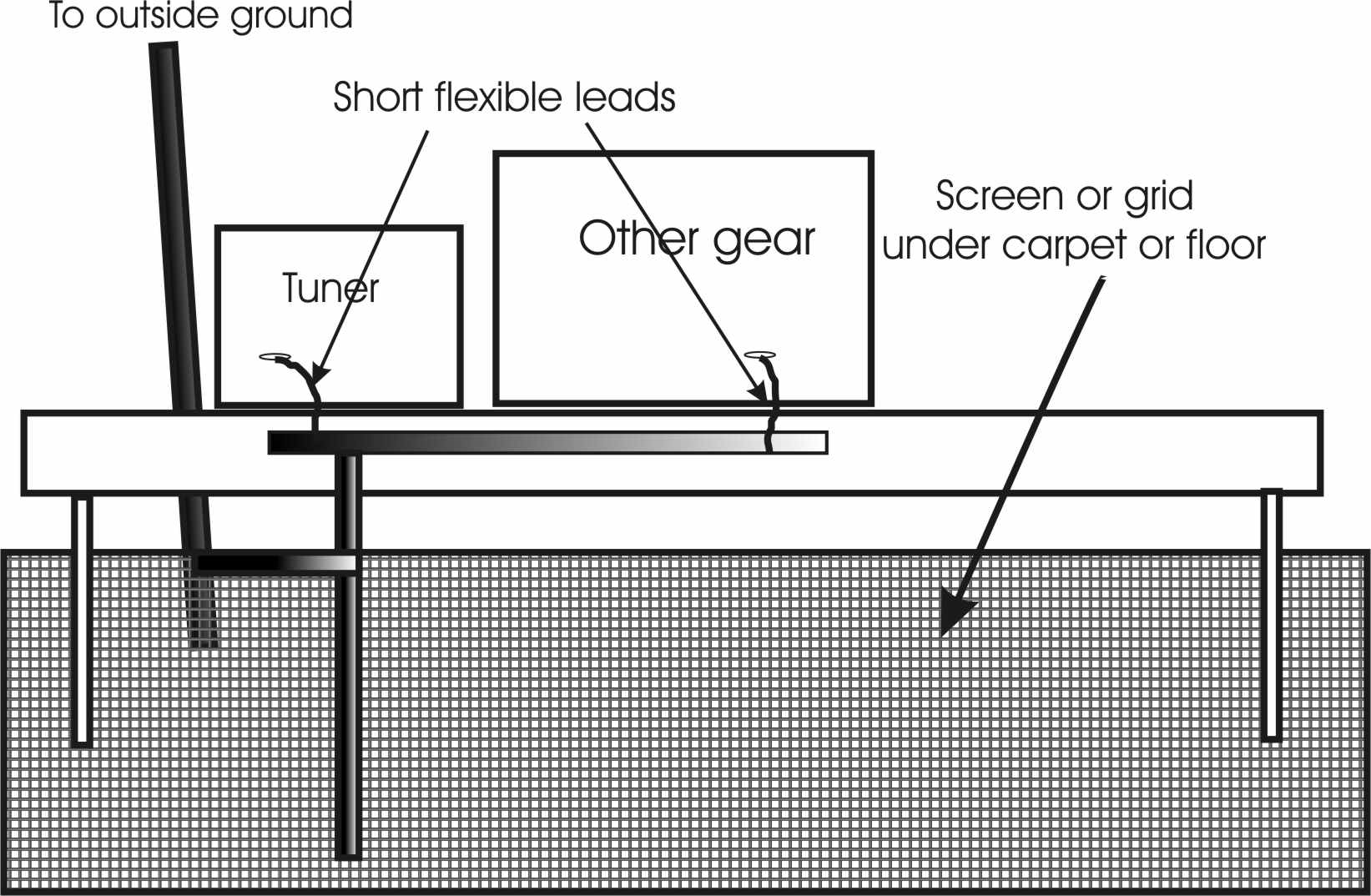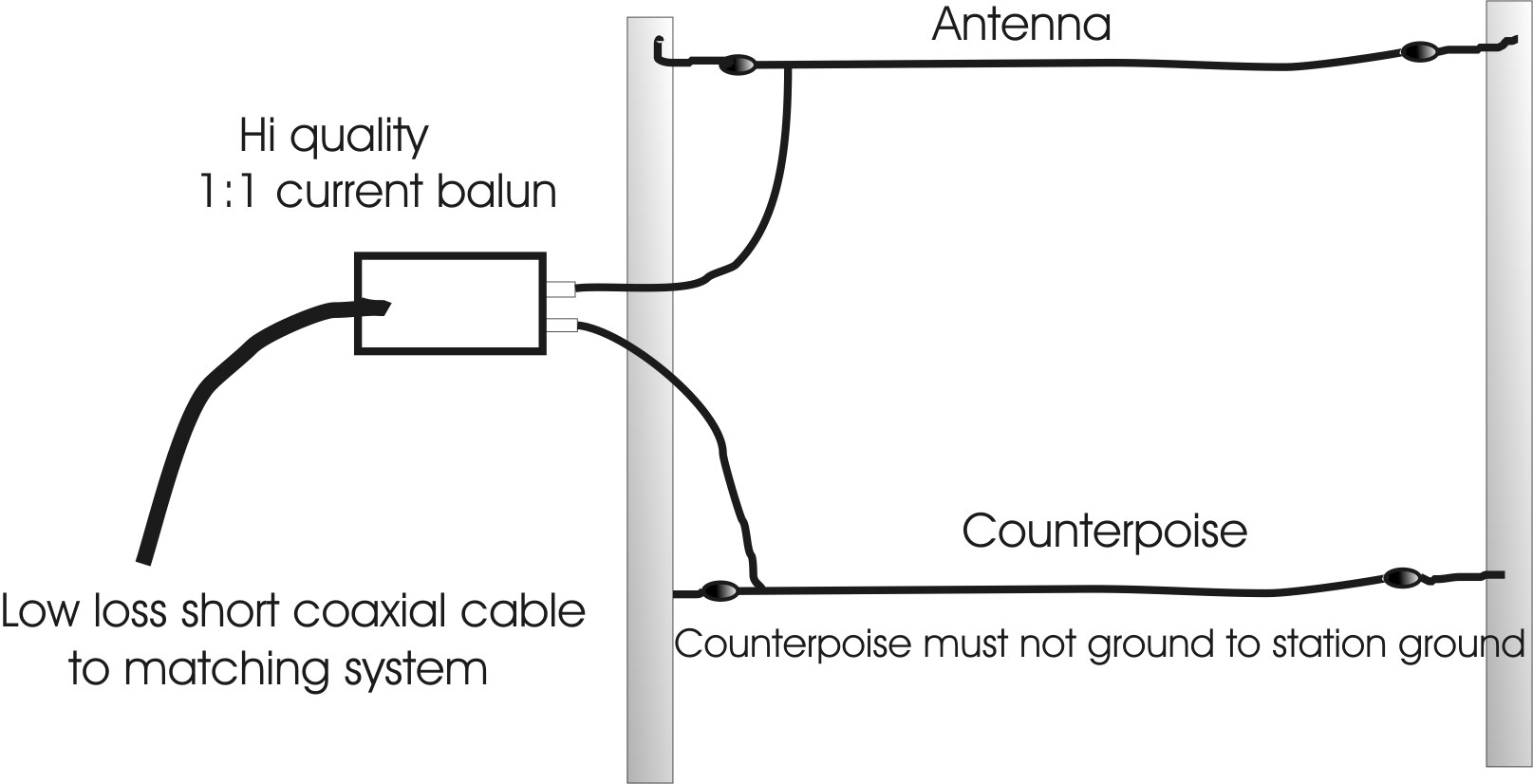Technically a true "longwire" needs to be at least one wavelength long, but Hams commonly call any end-fed wire a longwire or random wire antenna. Long wire or random wire antennas are very simple antennas. They can come close to half wave antennas in efficiency, although efficiency decreases as they are made very long or installed closer to earth. Like every antenna that exists, random or long wires have advantages and disadvantages. Because the radiating area is often brought into or near the operating position, longwires often create RF interference to consumer goods or RF in the operating room. The easy installation part comes from generally needing only two supports, and not having a heavy feedline hanging from mid-span like a dipole. The long expensive feed cable normally associated with a doublet or dipole is not needed, the antenna wire itself serving as a "feedline". The antenna itself works just as well as any other wire of similar height and length. Any or all problems are in the counterpoise and feed system. The difficult problems associated with random wire or longwire antennas are caused by ground currents and radiation from the single wire feeder. How the Longwire or Random Wire Antenna Works The antenna element works the same as any other antenna. Electromagnetic radiation comes from current flowing over a spatial distance along the wire. The single wire feeder not only radiates electromagnetic energy, it has very strong electric and magnetic induction or energy storage fields surrounding the wire for some distance out from the wire. In order to force current up into the feed wire and antenna, the matching or feed system has to "push against" something else. For every milliampere of current flowing into the feed wire of the longwire antenna, an exactly equal current has to flow into a ground system of some type! In any non-terminated antenna, currents and voltages are transformed along the antenna. This transformation is caused by standing waves. This means ground lead currents can increase or decrease along the ground wire and everything connected to the ground wire or ground system. Voltage changes also along the ground or counterpoise system, just as it does in antennas. The voltage caused by antenna return currents, and the return current, will become stronger (more intense) or weaker (less intense) because of standing waves on wiring and equipment cases. These ground currents, displacement currents, or common mode currents cause everything connected to the matching system to become "hot" with RF. The result is generally all sorts of RF interference to active devices or even physical harm to the operator, such as actual burns or on lower bands like 160-meters..... electrical shocks! These unwanted but very necessary currents ideally should flow through the lowest impedance path and widest area path we can manage. Noise from Longwire Antennas Radiation and fields surrounding the single wire feed system not only leak out, unwanted noise and signals can also leak in. Radiation from the feeder and everything connected to the matching system, as well as common mode currents, also allows common mode noise ingress. This deteriorates receiving system noise performance. Common mode currents and induction field coupling also decreases transmitting efficiency. This effect adds unnecessary loss to the system. If things are just right (like having a fairly good RF ground in the shack) and power is fairly low, we can often "get away" with having a random wire or longwire brought directly into the shack, but that is more a matter of good fortune than good planning. Repeating and expanding on what was said above, radiation and fields surrounding the single wire feed system not only leak out, unwanted noise and signals can also leak in. This is an unsolvable problem with a single wire feed. The very best we can do is relocate these problems to an area where they cause no noticeable problems. We can do this by relocating the feedpoint. Relocating the feedpoint can move strong magnetic and electric fields away from the operating position, house wring, consumer devices, and our sensitive equipment. This reduces noise into the antenna feed system, and RFI caused by the antenna feed system. Method 1, grounding Ground rods have limited effectiveness, except perhaps on very low frequencies. This is not saying we should not have ground rods, but rather depending on them for RF grounds is not a good idea. The RF ground should if possible contain radials or counterpoise wires and not just ground rods. Ground rods do very little good for RF! As a matter of fact adding ground rods can decrease RF efficiency when an insulated counterpoise is used. With fairly low power and good luck, one way to mitigate noticeable problems is a ground plane at room level. This ground system can be as simple as strips of foil laid under a carpet. These conductive wide strips of foil would then be connected back to a wide station equipment ground buss. Stained-glass hobby suppliers sell adhesive backed copper foil that works very well, and is easily soldered. Another choice is aluminum foil, but this requires pressure connections that tend to be less reliable over time. As an alternative to copper foil strips, a metal screen or grid of wires at floor level can be used. This system can be right under the carpet, or can even be directly below the floor. it is important whatever is used, that is have a low impedance RF connection to the cabinets or chassis all desk equipment. This type of counterpoise system makes the entire room, including the operator, "rise" in voltage and match the equipment chassis voltages. It also disperses or spreads the current and voltage around, reducing intensity of localized electric and magnetic fields. This is very effective for a second floor (or higher story) RF ground. Like standing on a metal plate carrying high currents, there is little potential difference between different areas of the high-conductivity counterpoise sheet. The antenna lead from the tuner "longwire" terminal to the antenna should parallel and be reasonably close to the outside ground lead, if possible. This forms a two-wire transmission line, which helps to reduce external fields. the single wire feeder should be kept away from the operator and RF sensitive equipment. The lead to the longwire antenna should be as short and direct as reasonably possible, because the feed wire is a leaky transmission line. The grid of foil, metal screen, or wire grid does not need to be too dense. Below 30 MHz, spacing conductors one to two feet apart is nearly as effective as a solid sheet. If we can't do that, then sometimes a 1/4 wave counterpoise along the baseboard will work. But it is fart better to disperse the current in a widely spread-out path, making all areas of the operating area have similar RF potential without concentrated currents. Method 2, Keep Problems Outside The best method of taming a long wire is to install a good low-loss current or choke balun just outside the operating room. This effectively puts distance between the leaky feeder and radiating ground leads outside and away from sensitive equipment. System I A system like this is ideal for a minimal investment unobtrusive counterpoise. This system, even with a minimal RF ground, keeps common mode currents out of the operating area. This system reduces noise and RFI. It generally eliminates the need for a shack "floor groundplane". The balun must be a reliable current balun with high common mode impedance. A voltage balun, or a single core 4:1 balun, will make things worse. The counterpoise can be a ground system like radials instead of a single counterpoise. It just cannot connect back to the station entrance ground, or the balun's ground. If it is a single wire or a few wires, they should be insulated from earth and kept a little distance above earth. Ideally the single wire counterpoise should be directly under the longwire antenna, and a few feet above earth. Remember the counterpoise will have considerable current and voltage, and might be an RF burn or shock hazard. The balun has to be a high quality current balun. It should be a 1:1 ratio with high common mode impedance and high voltage breakdown. The coaxial feedline, since it operates at high SWR, should be high quality and as short as possible. Ideally the counterpoise wire should be elevated above earth. This minimizes earth losses, and the counterpoise should not be connected to a ground rod or especially to the station ground. The required lightning and safety grounds must all be on the coaxial side of the balun. Unless the ground system is nearly perfect with near-zero RF impedance, it is best to keep the antenna's ground or counterpoise isolated from the feedline shield and station equipment. System II A better ground improves efficiency. A better ground also allows connection of all ground systems together, no longer requiring RF be isolated from earth and confined to a hot counterpoise. The ideal system, in which efficiency would nearly equal that of a balanced center fed system would be one similar to the radials on a vertical. Such a system would minimize RFI and electrical noise problems. It would be a large system of buried or suspended wires that all share currents, preventing any current concentration in the lossy media surrounding the radials. One common misconception is a near-perfect ground needs 120 quarterwave or halfwave radials. This is not true, even 15-20 radials can form a very low loss ground. All we can do is install the best ground we can manage. The more wires used in a counterpoise or ground, and the more spread out they are, the less critical the system becomes.Long wire antenna random wire
Advantages Disadvantages no heavy expensive coaxial feedline hanging from the span single wire "feeder" and "ground lead" radiate very simple to install and construct can be a problem for lightning excellent stealth antennas single wire feedline can be burn or shock hazard inexpensive require a tuner or matching system Curing RFI and Reducing Noise, and Optimizing Performance, with Single Wire Feeds


Wednesday, July 20, 2011
Long wire antenna random wire
Subscribe to:
Post Comments (Atom)

No comments:
Post a Comment